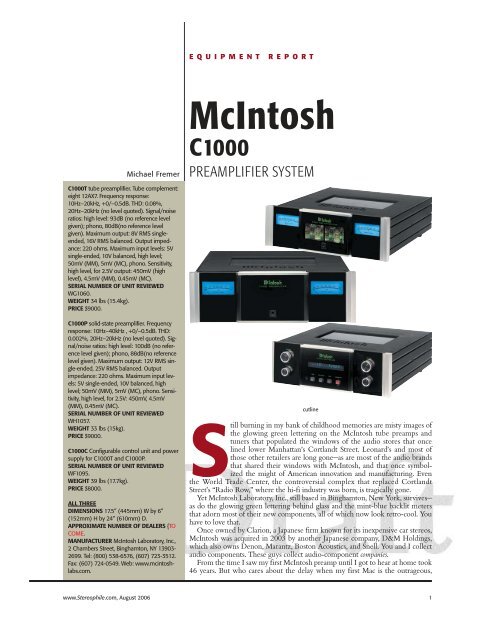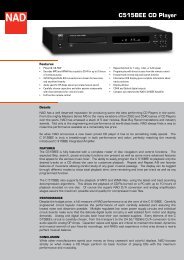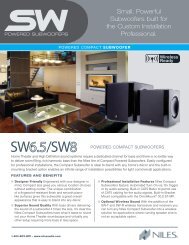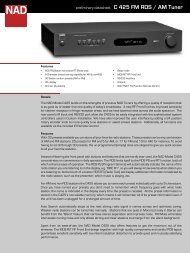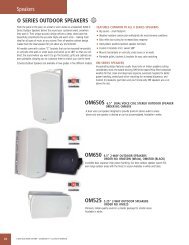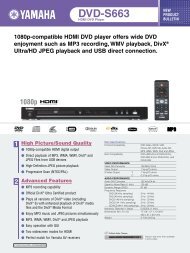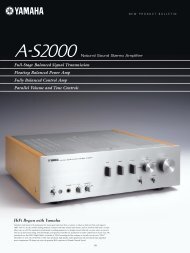McIntosh C1000 Stereophile Review - The Listening Post
McIntosh C1000 Stereophile Review - The Listening Post
McIntosh C1000 Stereophile Review - The Listening Post
You also want an ePaper? Increase the reach of your titles
YUMPU automatically turns print PDFs into web optimized ePapers that Google loves.
EQUIPMENT REPORTMichael Fremer<strong>McIntosh</strong><strong>C1000</strong>PREAMPLIFIER SYSTEM<strong>C1000</strong>T tube preamplifier. Tube complement:eight 12AX7. Frequency response:10Hz–20kHz, +0/–0.5dB. THD: 0.08%,20Hz–20kHz (no level quoted). Signal/noiseratios: high level: 93dB (no reference levelgiven); phono, 80dB(no reference levelgiven). Maximum output: 8V RMS singleended,16V RMS balanced. Output impedance:220 ohms. Maximum input levels: 5Vsingle-ended, 10V balanced, high level;50mV (MM), 5mV (MC), phono. Sensitivity,high level, for 2.5V output: 450mV (highlevel), 4.5mV (MM), 0.45mV (MC).SERIAL NUMBER OF UNIT REVIEWEDWG1060.WEIGHT 34 lbs (15.4kg).PRICE $9000.<strong>C1000</strong>P solid-state preamplifier. Frequencyresponse: 10Hz–40kHz , +0/–0.5dB. THD:0.002%, 20Hz–20kHz (no level quoted). Signal/noiseratios: high level: 100dB (no referencelevel given); phono, 88dB(no referencelevel given). Maximum output: 12V RMS single-ended,25V RMS balanced. Outputimpedance: 220 ohms. Maximum input levels:5V single-ended, 10V balanced, highlevel; 50mV (MM), 5mV (MC), phono. Sensitivity,high level, for 2.5V: 450mV, 4.5mV(MM), 0.45mV (MC).SERIAL NUMBER OF UNIT REVIEWEDWH1057.WEIGHT 33 lbs (15kg).PRICE $9000.<strong>C1000</strong>C Configurable control unit and powersupply for <strong>C1000</strong>T and <strong>C1000</strong>P.SERIAL NUMBER OF UNIT REVIEWEDWF1095.WEIGHT 39 lbs (17.7kg).PRICE $8000.ALL THREEDIMENSIONS 17.5” (445mm) W by 6”(152mm) H by 24” (610mm) D.APPROXIMATE NUMBER OF DEALERS {TOCOME.MANUFACTURER <strong>McIntosh</strong> Laboratory, Inc.,2 Chambers Street, Binghamton, NY 13903-2699. Tel: (800) 538-6576, (607) 723-3512.Fax: (607) 724-0549. Web: www.mcintoshlabs.com.cutlineStill burning in my bank of childhood memories are misty images ofthe glowing green lettering on the <strong>McIntosh</strong> tube preamps andtuners that populated the windows of the audio stores that oncelined lower Manhattan’s Cortlandt Street. Leonard’s and most ofthose other retailers are long gone—as are most of the audio brandsthat shared their windows with <strong>McIntosh</strong>, and that once symbolizedthe might of American innovation and manufacturing. Eventhe World Trade Center, the controversial complex that replaced CortlandtStreet’s “Radio Row,” where the hi-fi industry was born, is tragically gone.Yet <strong>McIntosh</strong> Laboratory, Inc., still based in Binghamton, New York, survives—as do the glowing green lettering behind glass and the mint-blue backlit metersthat adorn most of their new components, all of which now look retro-cool. Youhave to love that.Once owned by Clarion, a Japanese firm known for its inexpensive car stereos,<strong>McIntosh</strong> was acquired in 2003 by another Japanese company, D&M Holdings,which also owns Denon, Marantz, Boston Acoustics, and Snell. You and I collectaudio components. <strong>The</strong>se guys collect audio-component companies.From the time I saw my first <strong>McIntosh</strong> preamp until I got to hear at home took46 years. But who cares about the delay when my first Mac is the outrageous,www.<strong>Stereophile</strong>.com, August 2006 1
MCINTOSH <strong>C1000</strong>totally over-the-top bling-bling of thethree-box <strong>C1000</strong> preamplifier system?It’s got three sets of glowing green letteringbehind glass, two sets of meters—even a row of tubes glowing sexily in a“storefront” window complete with aceiling mirror that doubles the visualdrama. And it costs only $26,000.<strong>The</strong> three-box solutionWhy argue over whether tubes orsolid-state sounds better when you canhave both? <strong>The</strong> <strong>C1000</strong> consists of the<strong>C1000</strong>C controller/power supply andtwo separate, fully balanced preamplifiers,one solid-state, one tubed. Oneneedn’t buy both preamps to go withthe <strong>C1000</strong>C controller, but I’d bet100% of buyers plunking down$17,000 for the controller ($8000) andone module ($9000) opt for both, forthat total of $26,000.<strong>The</strong> <strong>C1000</strong>C controller has knobsfor Volume, Balance (remember that?),Source selection, and the Record Outselector, and provides power and controlsignals to one or both preamplifiersvia individual umbilical cords foreach channel of each preamp.Aside from the amplificationmethodology, the <strong>C1000</strong>T (tube) and<strong>C1000</strong>P (transistor) preamps are identical,offering nine sources each,including both moving-coil (MC) andmoving-magnet (MM) inputs. <strong>The</strong>reare three sets of balanced inputs andfour sets of unbalanced, not includingthe unbalanced MM/MC inputs.Three sets of balanced outputs allowfor convenient triamping, if you’re soinclined. Two unbalanced outputsallow for biamping in unbalancedmode. Because each preamp has itsown inputs and outputs, double runs ofcables are required for each amplifierMEASUREMENTSIperformed full sets of measurements on both <strong>McIntosh</strong>preamplifiers, for both balanced and unbalancedoperation, but the two units turned out to be electricallyso similar that I’ve combined my comments onboth into a single sidebar.<strong>The</strong> phono stages, of course, are unbalanced only; Iexamined their behavior at each preamp’s Processor Outjacks. <strong>The</strong> MM stages of the <strong>C1000</strong>P and <strong>C1000</strong>T are noninvertingand offered a voltage gain of 40.1dB and aninput impedance of 47k ohms across most of theaudioband, the latter dropping inconsequentially to 42.5kohms at 20kHz. Both MC stages were also noninvertingand offered 60.1dB of voltage gain at 1kHz, with an inputimpedance of 30 ohms when set to “25” and 960 ohmswhen set to “1000.”<strong>The</strong> <strong>C1000</strong>P’s RIAA error (fig.1) showed a very slightexcess of energy in the upper bass and above theaudioband, but was otherwise flat. <strong>The</strong> <strong>C1000</strong>T’s RIAAerror (fig.2) was very similar at audible frequencies, butfeatured an increasingly positive error at ultrasonic frequencies.This suggests that the tube preamp’s phonostagegain asymptotically approaches unity with rising frequencyrather than, as I prefer to see, continuing todecrease. This behavior will not in itself be audible, butthe late John Linsley-Hood suggested a quarter centuryago that it might increase the audibility of record clicks,particularly with MC cartridges. Why would the two <strong>McIntosh</strong>preamps differ in this respect? I can surmise only thatthe more limited voltage gain available from tubes meantthat a different circuit topology had to be used.At normal levels, the phono-stages’ THD+noise wasaround 0.017%, which is excellent. Both tubed and solidstatephono stages excelled in a potentially more importantarea: their immunity to overload. <strong>The</strong> MM and MCstages of both the <strong>C1000</strong>P and <strong>C1000</strong>T offered a superb27dB or greater overload margin at all audio frequencies(ref. 5mV, MM, and 500µV, MC, both at 1kHz). <strong>The</strong> <strong>McIntosh</strong>preamps’ phono stages are also extremely quiet—theunweighted audioband signal/noise ratios were 78.5dB(<strong>C1000</strong>P) and 69.4dB (<strong>C1000</strong>T) from the preamps’ MMinputs, and only slightly lower from their MC inputs—meaning that, with their very high overload margins, theyhave commendably high dynamic range, especially thesolid-state <strong>C1000</strong>P. One thing should be noted about the<strong>C1000</strong>T: When I was exploring the point at which itsphono-stage output clipped at 20kHz, I experienced somelatching; ie, once the circuit had clipped, it stayed clippedeven after I’d reduced the input-signal level. However, asthe output level was around 12V when this happened, itshould have no practical consequences.<strong>The</strong> <strong>C1000</strong>P’s and <strong>C1000</strong>T’s line stages offered a maximumof 15dB of voltage gain in both balanced and unbal-Fig.1<strong>McIntosh</strong> <strong>C1000</strong>P, MM stage RIAA error (0.5dB/vertical div., rightchannel dashed).Fig.2<strong>McIntosh</strong> <strong>C1000</strong>T, MM stage RIAA error (0.5dB/vertical div., rightchannel dashed).www.<strong>Stereophile</strong>.com, August 2006 2
CO. NAME & PRODUCT NAMEchannel, for a total of four for a conventionallyamplified system, or twelvecables for a balanced triamplifiedstereo system. Both preamps convertunbalanced signals to balanced, andvice versa. Each preamp has a headphonejack mounted in the center of itsfront panel.<strong>McIntosh</strong>’s balanced power amplifiers,intended for use with the <strong>C1000</strong>,have two balanced inputs. <strong>McIntosh</strong>supplies combiner modules for singleinputbalanced amps. <strong>The</strong>se also allowas two balanced inputs to be convertedto three, allowing for a long pair of balancedcables for each channel to be runfrom the preamplifiers, and, for eachchannel, short runs from the modulesto the three amplifiers of a triampedsystem.Once you’ve got the <strong>C1000</strong> talkingto your amplifier, it’s time to connectyour balanced and unbalanced sourcecomponents, which can be used simultaneously.Which to connect to thetubed preamp and which to the solidstate?Your choice. <strong>The</strong> only way tofind out which you prefer is to tryboth. However, thanks to a balancedrecording link, you can get the recordoutsignal (balanced and/or singleended)from either preamp’s RecordOut jacks.With everything connected, it wastime to power up. <strong>The</strong> <strong>C1000</strong> ismighty handsome even when turnedoff, but oh my—nothing in my experiencehas looked any cooler or moreelegantly blinged-out than these threeboxes with their lights on and mine off.What’s insideAside from its dual-mono power supplies,the <strong>C1000</strong>C controls the signalrouting and source selection for thepreamplifier modules. When other<strong>McIntosh</strong> components are connectedto the <strong>C1000</strong>’s data ports, basic controlfunctions are automatically handled bythe remote control; turning the <strong>C1000</strong>on or off with the remote turns all connected<strong>McIntosh</strong> gear on or off.<strong>The</strong> <strong>C1000</strong>C’s volume control is adigital optical encoder: as the knob isrotated, two internally mounted sensorsreceive a beam of infrared light as aseries of digital pulses. A microprocessorcounts the number of pulses to control a<strong>McIntosh</strong>-designed electronic attenuatorthat provides 213 steps in 0.5dBincrements while maintaining channelbalance to within 0.1dB.While most preamplifiers use a singlevolume control placed ahead of thegain stage, <strong>McIntosh</strong> says that whilethis results in wide dynamic range andmeasurements, continuedanced operation, with 0dB on the meters (which comeafter the volume control) indicating when the preamp isreaching the limit of its dynamic range capability. <strong>The</strong>input impedance of both preamps was 16.5k ohms acrossmost of the audioband for the unbalanced inputs, 25kohms for the balanced, these decreasing slightly butinconsequentially at 20kHz. All inputs preserved absolutepolarity (ie, were noninverting), the XLRs being wired withpin 2 hot.Both preamplifier line stages offered the identical widefrequency response into 100k ohms (fig.3, top pair oftraces), with a slightly early rolloff of low-bass frequenciesinto the punishing 600 ohm load (fig.3, bottom traces).<strong>The</strong> response was identical from both the balanced andunbalanced jacks and at all volume-control settings. Anycrosstalk was buried under the noise (fig.4 shows thechannel separation for the <strong>C1000</strong>T) and the noise floorwas very low in level—particularly for the <strong>C1000</strong>P, which,with its input shorted but its volume control set to its maximum,gave an unweighted, wideband S/N ratio (ref.1VFig.4<strong>McIntosh</strong> <strong>C1000</strong>T, channel separation, balanced operation (bottom)and unbalanced (top). (10dB/vertical div., R–L dashed.)Fig.3<strong>McIntosh</strong> <strong>C1000</strong>P, balanced frequency response at 1V into 100kohms (top below 200Hz) and 600 ohms with volume control at“100” (0.5dB/vertical div., right channel dashed).Fig.5<strong>McIntosh</strong> <strong>C1000</strong>P, balanced distortion (%) vs 1kHz output level into(from bottom to top at 1V): 100k and 600 ohms.3 www.<strong>Stereophile</strong>.com, August 2006
MCINTOSH <strong>C1000</strong>freedom from overload, noise increasesas the volume is lowered. Lower backgroundnoise can be achieved by placingthe volume control after the gainstage, but at the expense of dynamicrange and the ability to prevent inputoverload. <strong>McIntosh</strong>’s solution is to usetwo volume controls, one before thegain stage and one after; they claimthat this results in wide dynamic range,freedom from input overload, and animpressively low noise floor of–118dB. <strong>The</strong> two volume controls arelinked together and controlled by what<strong>McIntosh</strong> calls a Dynamic ControlMultiplexer.<strong>The</strong>re is a separate Mute button;when you mute the <strong>C1000</strong>, the soundstops suddenly and completely, thoughit ramps up pleasantly when you wantto listen again. I liked that feature.For the <strong>C1000</strong>, <strong>McIntosh</strong>’s engineersdeveloped a new, fully shielded,low-noise MM/MC phono preamplifierthat can handle medium-low-output(0.45mV) MC cartridges withoutneeding a step-up transformer.Ultralow noise is claimed, thanks tothe shielding and a dedicated doublefilteredpower supply. Both the tubed(four 12AX7s) and solid-state phonopreamps are specced equally in termsof MM/MC input sensitivity, thoughthe solid-state model’s signal/noiseratio is 88dB to the tubed version’s80dB. Both offer the same loadingfacilities: for MM, 47k ohms, with50–750pF in steps of 50pF; for MC,25, 50,100, 200, 400, or 1000 ohms, inparallel with 100pF.Setup and programming<strong>The</strong> <strong>C1000</strong>C controller’s Setup mode(push the Setup button) will confoundaudiophiles used to straightforwardplug-and-play preamplifiers. (Thankgoodness I’ve set up and programmedhome-theater receivers.) While youcan operate the <strong>C1000</strong> with its factorydefault settings, it makes more sense totake advantage of its flexible configurability.In fact, for certain functions,you’ll have to. Within Setup mode, theListen, Balance, and Record buttonsassume fresh identities that can be confusingif you’re not careful. It’s easy toget lost in the maze of possibilities, andonce you’ve made a change, it’s easy toforget what you did, and damned difficultto figure out how to get back towhere you once were.At one point, I auditioned the latestversion of Merlin’s VSM loudspeakerfor a Follow-Up review. Programmingthe <strong>C1000</strong>’s processor loop so it wouldpass through the unit’s electronic BAMoutput) of 116dB! <strong>The</strong> <strong>C1000</strong>T was not in that class butwas still good, with the same measurement giving 76dB,which improved to 88dB when A-weighted.<strong>The</strong> <strong>C1000</strong>P and <strong>C1000</strong>T could both swing very highoutput voltages. Figs.5 and 6 show how the percentage ofTHD+noise present in the balanced outputs of the ’P and’T, respectively, changed with output voltage into 100kohms and 600 ohms. <strong>The</strong> solid-state preamp clipped (1%THD+N) at 32.5V into the higher impedance and at 18Vinto the low load, with the maximum unbalanced outputhalf these figures, as expected. <strong>The</strong> tube preamp clippeda little earlier, at 20V into 100k ohms and 11.3V into 600ohms, but the difference is academic—any power amplifierwill be driven well into overload at these levels.<strong>The</strong> downward slope below 10V of the traces in figs.5and 6 suggests that actual distortion is buried under thealready low noise at normal signal levels. To examine howthe THD+N percentage changes with frequency, I thereforechose a high output level: 10V for the <strong>C1000</strong>P (fig.7)and 5V for the <strong>C1000</strong>T (fig.8). Into high impedances, theTHD+N remains constant with frequency in theFig.7<strong>McIntosh</strong> <strong>C1000</strong>P, balanced THD+N (%) vs frequency at 1V into(from bottom to top): 100k and 600 ohms (right channel dashed).Fig.6<strong>McIntosh</strong> <strong>C1000</strong>T, balanced distortion (%) vs 1kHz output level into(from bottom to top at 1V): 100k and 600 ohms.Fig.8 <strong>McIntosh</strong> <strong>C1000</strong>T, balanced THD+N (%) vs frequency at 1V into(from bottom to top): 100k and 600 ohms (right channel dashed).www.<strong>Stereophile</strong>.com, August 2006 4
MCINTOSH <strong>C1000</strong>bass equalizer was a nerve-rackingexperience requiring the combinedbrain power of three not-stupid individuals.<strong>The</strong> instructions try to beexplicit, but too few examples are provided—andif you don’t get it right, youget no sound.Among the Setup features are inputleveltrim, so that the volume doesn’t“jump” between inputs; a Pass Thrumode for use in a multichannel sound orhome theater system; adjustments forthe fluorescent display and meter brightness;input title reassignment (forinstance, if you have a DVD playerplugged into the Aux input, you canchange that input’s label to read“DVD”). And, of course, in Setup modeyou can change MM capacitance andMC resistive loading. You can even setthe <strong>C1000</strong> for mono operation, via theSetup menu or the remote control.Actually, there are two remote controls:a plastic, full-function, A/V receiver typethat can control other <strong>McIntosh</strong> products,and a hefty model of extruded,anodized aluminum that controls basicfunctionality. <strong>The</strong> latter is the one you’lluse most of the time, especially whenyou show off your <strong>C1000</strong> to friends.Using the <strong>C1000</strong>When you have both the <strong>C1000</strong>Psolid-state and <strong>C1000</strong>T tube preampsconnected, the <strong>C1000</strong>C will recognizethe fact and double your input-selectionoptions. Scrolling through theseoptions can be tedious, especially whenyou’re not using all of them: CD1,D/A, PH/MM1, PH/MC1, DVD2,Aux2, Tuner2, Srvr2, CDR2, CD2,PH/MM2, PH/MC2, CD3, Srvr3,CDR3, Srvr1, CDR1. Early on I reassignedone input but can’t remembernow what I did. I kept forgetting whatwas where, and often did a lot of huntingto find the input I wanted, but itwas hardly painful. Otherwise, onceeverything’s up and running and programmedto your liking (a big otherwise),using the <strong>C1000</strong> is easy.<strong>The</strong> <strong>C1000</strong>C switched between thetubed and solid-state preamps seamlessly,the meters on each are activatedonly when that preamp is selected. Asfor which you’ll end up using for eachsource, that will take some experimenting—onepreamp or the other willsurely be more complementary to eachTHE <strong>C1000</strong>P SOLID-STATE PREAMP DELIVERED ABLOOM USUALLY ASSOCIATED WITH TUBED GEAR,WHILE THE TUBED <strong>C1000</strong>T PRODUCED THE EVEN-HANDED TONAL BALANCE AND NEUTRALITY ONEUSUALLY ASSOCIATES WITH SOLID-STATE.source. That said, the tubed and solidstatepreamps sounded more alike thannot, which is how it should be.A sonic delicacyWhile the <strong>C1000</strong> outputs single-endedsignals, I felt it important also to listenin balanced mode, so I borrowed a pairof mbl 9007 balanced monoblockpower amplifiers (review in theworks). I also auditioned the <strong>C1000</strong>using my reference Musical FidelitykW single-ended monoblocks.<strong>The</strong> <strong>C1000</strong>’s sound remained consistentrun either balanced or singleended.<strong>The</strong> <strong>C1000</strong>P solid-state preampdelivered a bloom usually associatedmeasurements, continuedaudioband for both the ’P and ’T, the former offering avery low 0.001% or less compared with the latter’s stilllow0.016%. Into 600 ohms, however, these graphs showthat the actual THD rises at both very low and very highfrequencies, though not to any extent that might evenbegin to be audible.At normal levels, spectral analysis reveals that the harmoniccontent is vanishingly low for both preamps:0.0005% (true sum of the harmonics; fig.9, <strong>C1000</strong>P;fig.10, <strong>C1000</strong>T). <strong>The</strong> increase in THD at low frequenciesand high levels into 600 ohms was due primarily to anincrease in the subjectively innocuous third harmonicFig.9<strong>McIntosh</strong> <strong>C1000</strong>P, unbalanced spectrum of 1kHz sinewave,DC–10kHz, at 1V into 8k ohms (linear frequency scale).Fig.10 <strong>McIntosh</strong> <strong>C1000</strong>T, unbalanced spectrum of 1kHz sinewave,DC–10kHz, at 1V into 8k ohms (linear frequency scale).www.<strong>Stereophile</strong>.com, August 2006 5
MCINTOSH <strong>C1000</strong>with tubed gear, while the tubed<strong>C1000</strong>T produced the even-handedtonal balance and neutrality one usuallyassociates with solid-state. While therewere sonic differences to be heard runningthe Musical Fidelity kW SACDplayer through each preamp, the differenceswere minor: a bit more bloom,and slightly softer, riper bass in the caseof the <strong>C1000</strong>T. But the kW has its ownsolid-state and tubed outputs. By switchingthose around, I could achieve thesame sound using either <strong>McIntosh</strong> preamp.<strong>The</strong> kW’s solid-state output intothe tubed <strong>C1000</strong>T sounded very similarto the kW’s tubed output into the solidstate<strong>C1000</strong>P. Running the tubed kWinto the tubed <strong>McIntosh</strong> producedmore warmth and bloom than I like,but your taste may differ.Run through either pair ofmonoblocks, both the solid-state andtubed preamps sounded intoxicatinglyliquid, with astonishing purity, delicacy,and transparency. While few good preampsin my experience present electronic“noise” as audible noise, the differencebetween the quietness of most preampsof my experience and the quietness ofthe <strong>C1000</strong> was easy to hear—or, rather,not hear. I could sense the <strong>C1000</strong>’s definitionof quietness in the elegance ofdecays, the roundness and three-dimensionalityof images, and, especially, in theutter ease of the overall sound.<strong>The</strong> <strong>C1000</strong>’s overall freedom frommechanical artifacts, particularly onsibilants and transients, helped producean entirely effortless sonic picture, yetwith either preamp, the sound wasnever too soft or warm. While the<strong>C1000</strong>’s ultralow noise floor producedmesmerizing, delicate microdynamicdetails, occasionally I felt that largescaledynamic swings were not quite asthunderous and powerful as they canbe—but once I’d gotten acclimated tothe <strong>C1000</strong>’s unusual ease and transparency,that proved to be an illusion.While in Texas recently to hearAndrew Litton and the Dallas Symphonyperform Mahler’s Symphony 2, Ipicked up a superb-sounding DelosCD of Litton and the DSO in the samework, recorded by John Eargle in thesame hall in which the concert tookplace: the gorgeous-sounding EugeneMcDermott Concert Hall of the MortonH. Meyerson Symphony Center.This warm, intimate, coherent-soundinghall has ideal reverberant decay andamong the best propagations of stringand bass sound I’ve ever heard live. <strong>The</strong>construction of the stage included acarefully designed hollow under thecello section to allow their sound to“breathe” with full expression. Myhosts had told me that some listenersare skeptical of the hollow’s success, butas the lower string players drew theirbows across the strings, I found theoverall richness, warmth, and texturalexpression almost overwhelming. Ironic,I thought, that this tubey-soundingspace was funded by one of the threefounders of semiconductor makerTexas Instruments, while the cold, sterile,analytical Avery Fisher Hall wasendowed by a man who made his fortuneproducing tubed electronics.<strong>The</strong> tubed CD-player output intothe <strong>C1000</strong>P solid-state preamp or thesolid-state CD-player output into the<strong>C1000</strong>T tubed preamp came closest toduplicating the sound I heard at eitherof the seats I occupied in McDermottHall (10th row center for the first half,dead center in the loge box for the secondhalf). When I ran the MusicalFidelity kW’s solid-state output intothe solid-state <strong>C1000</strong>P, the sound wasstill impressive, but some of the richnessI’d heard live was lost.<strong>McIntosh</strong> claims 130dB of channelseparation for this dual-mono, mirrorimagedesign. Judging by the spaciousnessof the sound, I’m sure JohnAtkinson’s measurements will back upthat claim.measurements, continued(fig.11), though at –88dB (0.006%) this won’t bother anyhuman listener. Intermodulation distortion was alsoessentially nonexistent at normal levels; I had to brutalizethe preamps by driving them close to clipping into 600ohms to get any significant evidence of high-order products(fig.12), and even then, the distortion productsremained at or below 80dB (0.01%)!<strong>The</strong> measured performance of these two <strong>McIntosh</strong> preamplifiersreveals some superb audio engineering, withno compromise evident for the tubed version apart fromsome slightly higher but still low noise levels and thatultrasonic RIAA error. It is very satisfying to measure suchproducts, and, as Mikey found, equally satisfying to listento them.—John AtkinsonFig.11 <strong>McIntosh</strong> <strong>C1000</strong>P, balanced spectrum of 50Hz sinewave, DC–1kHz,at 10V into 600 ohms (linear frequency scale).Fig.12 <strong>McIntosh</strong> <strong>C1000</strong>P, balanced HF intermodulation spectrum,DC–24kHz, 19+20kHz at 15V peak into 600 ohms (linear frequencyscale).www.<strong>Stereophile</strong>.com, August 2006 6
MCINTOSH <strong>C1000</strong>Phono preamps: tube vssolid-stateWith premium phono preamps costingas much as the <strong>C1000</strong>C controller plusone of the preamps, you might thinkthat the <strong>C1000</strong>T’s and <strong>C1000</strong>P’s builtinphono stages are mere afterthoughts.That didn’t prove to be the case. Boththe solid-state and tubed phono preampssounded exceptionally fine, andmaintained the line sections’ exceptionalquiet, coherence, harmonic completeness,delicacy, and dimensionality.However, only higher-output lowoutputMCs should be used. Fortunately,top-of-the-line cartridges withoutputs of 0.45mV, such as the LyraTitan i, are currently in vogue, as moreand more manufacturers finding waysto increase output without loweringresolution. <strong>The</strong> low noise floor of eventhe <strong>C1000</strong>T’s tubed phono sectionpermitted the use of lower-output cartridgeswithout making the dynamicssuffer. At least, that’s what I foundusing the luscious-soundingMiyabi/47 Labs cartridge with eitherphono preamp. But I wouldn’t golower than the Miyabi’s output of0.3mV.Joni Mitchell’s Blue (LP, RepriseMS 2038)—which I’ve been playing alot lately—proved the perfect foil foreither preamp’s phono section, withmy nod going to the 12AX7-based<strong>C1000</strong>T for its extra touches of delicacyand suppleness. With a finesense of studio acoustic, a real senseof hearing Mitchell before the microphonetakes her voice, and a guitarutterly believable in both image andharmonics, I can’t say I’ve heard thisrecord sound more satisfying.Each phono preamp delivered aninviting, delicate rendering ofacoustic music without wimping outon amplified material. <strong>The</strong> tubed<strong>C1000</strong>T’s phono preamp managedwarmth without enveloping thelower midrange in a blanket, and thesolid-state <strong>C1000</strong>P delivered detailwithout astringency.I also compared the <strong>C1000</strong>T and<strong>C1000</strong>P using the superb-soundingAtaulfo Argenta Edition, a boxed set ofLPs collecting the recordings of theSpanish conductor, who died in 1958at the age of 44 (Alhambra/Alto AnalogueAA006, out of print). Don’t listento the carpers who say that onlythe original—and impossible to find—Spanish edition will do. If you findthe Alto Analogue, don’t pass it up. Icompared this set’s edition of Argentaand guitarist Narciso Yepes’ recordingof Rodrigo’s Concierto de Aranjuez with aLondon “Blueback” ffss edition (CS6046), and while they were different, Icould make a case for either one. <strong>The</strong>Alto offered greater transparency and amore forward perspective; the Londonhad me sitting farther back in the hall.In any case, the tubed <strong>C1000</strong>T gaveYepes’ guitar a rich, delicate, andvibrant “golden” tonality, the solidstate<strong>C1000</strong>P a bit more transient fire—but this was only a change of seasoning,not a different entrée. That oneseasoning was produced by eight12AX7s and the other by transistors,and that both sounded so remarkablysimilar, especially in terms of harmonicstructure, is a testament to <strong>McIntosh</strong>Laboratory’s honest attempt in the<strong>C1000</strong> to not “flavor” the sound to suitpreconceived notions of what eithertechnology should deliver.ASSOCIATED EQUIPMENTANALOG SOURCES ContinuumAudio Labs Caliburn turntable; ContinuumCobra, Graham Phantomtonearms; Lyra Titan (stereo &mono), Miyabi/47 Labs cartridges.DIGITAL SOURCES Musical FidelitykW SACD player, Alesis MasterlinkBPT-modified hard-disk recorder.PREAMPLIFICATION Manley Steelhead,Blue Amp 42, PS Audio GCPH,Oracle Temple phono preamplifiers.POWER AMPLIFIERS Musical FidelitykW, mbl 9007 monoblocks.LOUDSPEAKERS Wilson MAXX 2,Merlin VSM.CABLES Phono: CrystalConnect Piccolo.Interconnect: Acrolink 6100,Shunyata Research Antares, TransparentAudio Reference, Harmonic TechnologyMagic Link One balanced.Speaker: Shunyata Research Orion,Transparent Reference. AC: JPS,Shunyata Research.ACCESSORIES Shunyata ResearchHydra 2, Hydra 8 power conditioners;Halcyonics Micro 40 active isolator;Continuum Castellon magneticisolation stand, Finite ElementePagode equipment stands; AudiodharmaCable Cooker; ASC TubeTraps, RPG BAD & Abffusor panels,Hallograph Sound Field Optimizers;VPI HW-17F, Loricraft PRC4 Deluxerecord-cleaning machines.—Michael FremerConclusions<strong>The</strong> <strong>McIntosh</strong> <strong>C1000</strong> is a complexmachine. Its flexibility is almost unlimited,and while some audiophiles believethat simplicity equals sonic purity, in thecase of the <strong>C1000</strong> you can have both.Chances are you’d never use all of itsfeatures, but that doesn’t mean you’d bewasting your money. Combine the<strong>C1000</strong>C controller with either preamplifierand you have a full-function preampof the highest order. You couldalways add the other preamp later; then,in addition to having sufficient inputsfor your and your neighbor’s stereos,you’d be able to season your system’scomponents to perfection.Configuring the <strong>C1000</strong> was complicatedand occasionally frustrating, butif you like puzzles, you’ll enjoy playingwith it. If you don’t, make sure yourdealer sets it up to your liking and iswilling to visit as needed to reconfigureit. Given these prices, it’s the least heshould be willing to do.<strong>The</strong> <strong>McIntosh</strong> <strong>C1000</strong> combinesultralow noise and ultralow distortionwith transparency, harmonic completeness,and, thanks to its ultralow noisefloor, resolution of low-level microdynamicsthat is unprecedented in myexperience. It delivered unrivaledimage specificity without unnaturaledge, layer on layer of detail, transientspeed and purity without soundinghyper, and delicacy and supplenesswithout sounding soft and soupy.While the tubed <strong>C1000</strong>T’s bass wasslightly less well controlled {than the<strong>C1000</strong>P’s?}, it compensated with texturalsuppleness. While the solid-state<strong>C1000</strong>P’s bass was not quite as suppleas the <strong>C1000</strong>T’s, it compensated withmuscular control. Yet it wasn’t the casethat one was mushy and the othermechanical. <strong>The</strong> <strong>C1000</strong> was like agreat dish whose individual ingredientsyou can’t taste—you just enjoy the finalblend of flavors without wanting moreor less of anything.Aside from its exquisite sound, the<strong>C1000</strong> is impeccably designed, engineered,and built. In terms of its dayto-dayoperation—turn-on, warmup,switching—the <strong>C1000</strong> performed likethe premium-priced luxury product itis (something that can’t be said of allexpensive audio gear). That it’s madein the USA by a company foundedmore than 50 years ago, is a reassuringthought even for those who can’tafford it. For you who can, it demandsyour attention.■■www.<strong>Stereophile</strong>.com, August 2006 7
CO. NAME & PRODUCT NAMEmeasurements, continued8 www.<strong>Stereophile</strong>.com, March 2006


